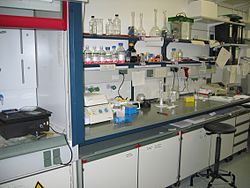Chemistry

| It matters Chemistry |
| Action and reaction |
| Elementary! |
| Spooky scary chemicals |
| Er, who's got the pox? |
Chemistry is the branch of science that studies the interaction between atoms, and how atoms form molecules and compounds and mixtures. The science mostly concerns itself with the activities of the outer electrons of atoms, protons and neutrons, as well as how these molecules interact with other molecules, and provides the basic rules on which biological sciences are based. Essentially, if someone marvels at how amazing it is that a protein folds together, or that coal and oil happen to burn to create energy, it is the rules governed by chemistry that make it happen.
Main sub-disciplines[edit]
- Organic chemistry: The study of molecules containing carbon, with the general exception of carbonates, carbon monoxide (CO), and carbon dioxide (CO2), which are studied mainly in other disciplines.[1] Experienced scents can range from delightful to so bad that villages miles away will be evacuated in the case of an emergency.[2][3]
- Inorganic chemistry: The study of a wide array of metal-containing compounds ranging from ionic salts to ligated metals, which may or may not contain carbon.[4] Experienced scents can range from non-existent to physically painful.
- Physical chemistry: The study of interatomic or intermolecular physics, such as thermodynamics, kinetics, and quantum chemistry. Experienced scents vary wildly depending on the experiment taking place.
- Biochemistry: The study of chemical reactions in living things. The most common scent is that of agar and solvents.
- Analytical chemistry: Identifying and quantifying the chemical make-up of samples. As atoms and molecules are too small to see, this is often quite demanding. Common tests range in complexity from burning samples to see what color the flame is to putting samples in giant electromagnets costing hundreds of thousands of dollars to see what they do. Experienced scents vary wildly depending on the procedure being used.
- Astrochemistry: the study of the chemical substances and species occurring in stars and interstellar space. Scents too far away from earth to be experienced, making this subfield relatively odorless.
Other areas[edit]
- Pharmaceutical chemistry: A combination of organic, organometallic, inorganic, and analytical chemistry used to produce and study end-effects of pharmaceuticals.
- Green chemistry: A quest to produce environmentally friendly chemicals and chemical processes.
- Photochemistry: The study of the interactions of chemicals with light, which often produces dramatically different results than merely heating the chemicals.
- Computational chemistry: The use of computers to perform numerical simulations to predict the behavior of atoms and molecules without conducting a "wet" chemistry experiment.
How far and how fast[edit]
- Thermodynamics: Best described as the energy of an atom or molecule. Thermodynamic driving forces cause certain products to be favored over others in reactions. The lowest energy, and therefore the most stable product, is the one eventually produced.
- Kinetics: Governs the speed of a reaction. The most stable product may not be the one produced because it is produced slowly. For example, graphite is much more stable than diamond, but diamonds still exist because their rate of decay to graphite is minutely small.
Benefits[edit]
Modern chemistry is capable of amazing things, both analyzing the exact structure of complex molecules and synthesizing naturally-occurring and "invented" molecules and substances. From dyes to plastics, to the processes that purify the silicon used in computer chips, the science of chemistry is inextricably linked with how the human race is able to live today.
Chemical bonding[edit]
Most atoms bond with each other by "sharing" "electrons" between their valence shells in what is known as a covalent bond. It is the breaking and making of such bonds that governs most, if not all of chemistry. When more than one atom is bonded together, the result is called a molecule, ranging from the small, such as methane, to the very large such as DNA. These bonds can be further split into non-polar and polar bonds: non-polar bonds "share" "electrons" relatively equally (e.g. between carbon and nitrogen), while polar bonds "share" "electrons" primarily to one side of the bond (e.g. between oxygen and hydrogen).
Ionic bonding is what occurs when "electron(s)" are overwhelmingly attracted to one side of a bond (e.g. between sodium and chlorine), to the point that it would be reasonably accurate to say that the "electron" is transferred from one atom to the other. This creates an ion. As an atom has an overall neutral charge, the removal of an electron leaves a positively charged ion and the addition of an electron leaves a negatively charged ion. Electrostatic forces then attract the positively charged ions to the negatively charged ions. An example of ionic bonding is in common salt, sodium chloride, which contains an equal number of positively charged sodium ions and negatively charged chloride ions bonded electrostatically.
Metallic bonding is a special (and complicated) type of bond that is difficult to describe simply. A simple way to explain it is that metals may be imagined as positively charged nuclei floating in a "sea" of negative charge where electrons are/ might be. The ability of electrons to move around easily "explains" the heat capacity, conductivity, malleability, and ductility of metals. This model is, however, generally taken to be a simplification on the scale of the Bohr model. A more accurate model is that of the Band Theory.[5]
References[edit]
- ↑ Garard, Ira D. An Introduction to Organic Chemistry. New York: John Wiley & Sons, Inc., 1932. Print.
- ↑ See the Wikipedia article on Thioacetone.
- ↑ Derek Lowe, Things I Won’t Work WIth: Thioacetone. Science Translation Medicine, 11 June 2009.
- ↑ Inorganic Chemistry. Archived from the original at the American Chemical Society, 22 Jul 2013.
- ↑ Metallic Bonding. chem.libretexts.org, 15 August 2020.